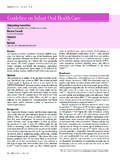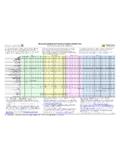Transcription of A GUIDE TO CARING FOR YOUR CHILD’S TEETH AND MOUTH
1 A GUIDE TO CARING FOR your child S TEETH AND MOUTHA COLLABORATION BETWEENUse this GUIDE to learn about oral health and taking care of your child s TEETH from birth to kindergarten and into their teen TO TOOTH TIME-PART OF THE SMILE SERIES-Did you know that how well you care for your child s teethwill affect his or her ability to learn and grow up healthy? By spending a few minutes each day to care for your child sbaby TEETH , you can be certain your child s smile will get off to a healthy start for a lifetime! Practicing good oral healthcare in your family will help protect your child s TEETH ,improve their overall health , and maintain their bright smile.
2 Disclaimer: Delta Dental of Minnesota provides oral health information to improve the dental health of ourcommunity. We believe they will make better oral health choices with this education. This GUIDE is not intend-ed to be used for the diagnosis or treatment of a dental or health condition and should not be used as a substi-tute for seeking dental or health care on a regular basis or when conditions warrant. Birth 18 monthsLearn about: Care of your infant s MOUTH and gums Teething babies Baby s first TEETH Tooth decay Dental visits Pacifiers Bottles Sugary drinks and foods18 months to 3 yearsLearn about: Good eating habits Sugary drinks and foods Brushing TEETH Pacifiers Bottles and sippy cups3 to 5 yearsLearn about: Protecting your child s TEETH when they are at school or a program away from home Pacifiers and thumb sucking Parent checklist Brushing TEETH Sugary drinks and foods5 to 18 yearsLearn about.
3 Role modeling Dental visits TEETH that come out Brushing TEETH Flossing TEETH Sugary drinks and foodsSome Germs Cause Cavities Germs can form easily in a baby smouth (even before the first teethcome in). Some germs cause toothdecay, so it is important to take care of your baby s MOUTH even before they get their first TEETH . Early childhood cavities, also calledbaby bottle tooth decay or nursingmouth, can destroy your child s teethand become a serious MOUTH infectionthat can be life-threatening if leftuntreated. You should also know thatthis infection can be prevented.
4 Parents, your oral health is also important to your child 's TEETH . Germsin your MOUTH can cause cavities andcan be passed along while feeding andcaring for your child . If you take careof your MOUTH , keep it clean and getyour dental work done, you don t passas many cavity-causing germs along toyour child . If you have cavities that are not filled, you have germs that can be passed on to your child throughbehaviors such as kissing and sharingeating utensils. Start cleaning your baby s MOUTH a few days after birth. Wipe your baby s gums with a clean damp washcloth after every feeding.
5 Avoid sharing spoons and cleaning your child s pacifier with your MOUTH . Do not pre-chew your child s food before feeding it to your child . Brush your TEETH daily and see the dentist regularly to maintain your oral FOR your BABY S MOUTH AND GUMSBIRTH TO 18 MONTHSAs early as six months, your baby may experience sore or tender gums as teetherupt. Gently rub your baby s gums with a clean finger, a small cool spoon, or awet gauze pad. Give your baby a cleanteething ring to chew for your Baby s First TEETH The front TEETH usually come in first. They may start coming in about six months after birth.
6 Most children have 20 baby ( primary ) TEETH by age three. Brush your child s TEETH (even if it s only one tooth!) with a soft toothbrushtwo times a day. Use a gentle, short, back-and-forth brushing motion. Brush for about 2 minutes using a tiny amount or smear of fluoride toothpaste. Make a dental appointmentby your child s first birthday. Baby TEETH are important, even though they fall out, because they help your child chew food, talk clearly and hold spaces for permanent TEETH . Have a plan to have your baby give uphis or her pacifier by age 2. CARING FOR your TEETHING BABYBIRTH TO 18 MONTHSTOOTH + SUGARY FOOD + GERMS = TOOTH DECAYBIRTH TO 18 MONTHSG erms that cause tooth decay are oftentransferred between parents/caregivers,other children and your baby by sharing or cleaning pacifiers, bottles/sippy cups and eating utensils.
7 Once the germs are present in yourchild s MOUTH , tooth decay begins whenthe germs are mixed with sugary foodsand drinks. Sweetened liquids containsugar, which will pool around yourchild s TEETH during sleep. If sugar mixeswith germs for a long period of time, it will form an acid that eats holes inyour child s TEETH . Do not allow your child to fall asleep with a bottle containing breast milk, formula, fruit juices or other sugary liquids. To soothe your child at bedtime, try soft music. Do not dip a pacifier in sweetened foods (sugar, honey or syrup) and let your child suck on it.
8 When you begin offering your child foods other than formula or breast milk, limit how often you serve sugary drinks and foods. Avoid letting older children share bottles, sippy cups, and eating utensils. If your child uses a sippy cup, don t allow them to use it all day, especially if it has juice or other sugary liquids in it. Encourage using a cup at meal times after age 1. Once cavities start, they can get worsequickly. PREVENTING TOOTH DECAYBIRTH TO 18 MONTHSYour child should visit a dentist bythe time he or she reaches one yearof age. The dentist can provide anynecessary treatment and informationon keeping his or her MOUTH healthyand your child to visit the dentistby playing a game of dentist orreading books about going to your child about what will happen at a dental visit.
9 Avoid saying things like, It won t hurt or Don t be scared. Consider bringing your child alongwhen an older sibling visits the den-tist, and talk to him or her about your dentist if your child needsfluoride varnish or other forms offluoride. TAKING your child TO THE DENTISTBIRTH TO 18 MONTHSH appy 1st Birthday! your dental check-up is and caregivers should take anactive role in the health of their child steeth by encouraging a healthy diet, andmonitoring daily brushing with fluoridetoothpaste. Another important habit isregularly looking at your child s teetheach month. It s called lift the lip.
10 This check should not replace yourchild s regular dental visits. Lifting the lip, parents can look forsigns of undetected tooth decay or otherpotential tooth problems: Changes in tooth color (white lines or brown spots) Holes on the tooth surface Broken or chipped TEETH Swollen or bleeding gumsChanges in your child s MOUTH should be reported to the dentist. By establishing regular oral healthhabits early in life, you can improve the oral health of your children onetooth at a THE LIP BIRTH TO 18 MONTHSU sing pacifiers or encouraging thumbsucking can affect the placement ofyour child s permanent (adult) a plan for helping your child giveup thumb sucking or the your child FROM THE PACIFIER18 MONTHS TO 3 YEARSIt s important to establish good eatinghabits when your child is meals and snacks, choose foodsfrom the five main food groups.


